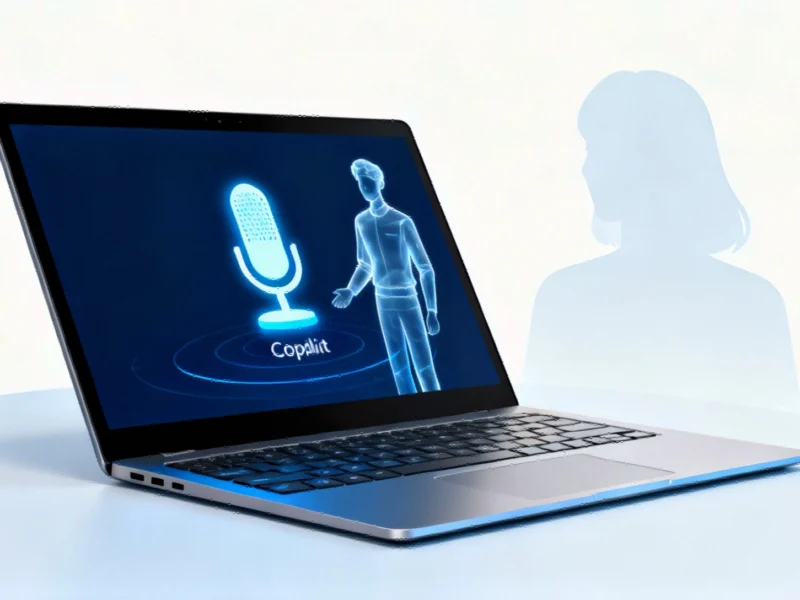Microsoft is pushing its AI assistant deeper into Windows 11 with new always-listening and screen-watching capabilities that are drawing mixed reactions from users and privacy advocates. The tech giant’s aggressive Copilot expansion comes as the company continues to integrate artificial intelligence throughout its operating system, despite ongoing concerns about functionality and data privacy.
The new features, announced by Microsoft’s consumer marketing chief Yusuf Mehdi, will bring Copilot Voice and Copilot Vision to “every Windows 11 device where Copilot is available.” This represents a significant expansion of Microsoft’s AI capabilities beyond what many users might expect from their operating system. The move follows a pattern of Microsoft pushing AI features that has sometimes resulted in problematic Windows updates affecting core system functionality.
How the new Copilot features work
Early testing by The Register’s US Editor Avram Piltch revealed that users can activate the voice feature with the wake phrase “Hey Copilot,” similar to smartphone assistants. However, the screen analysis capability requires manually clicking a Copilot Vision button. In Piltch’s testing, the feature successfully identified a mechanical keyboard shown in a web video and provided accurate pricing information when asked.
Despite these successes, the assistant demonstrated limitations in performing actual tasks. When asked to navigate to a website or open applications like Notepad, Copilot only provided instructions rather than executing the commands. This half-measure approach to automation leaves users with additional steps rather than true hands-free operation.
Privacy concerns in the wake of Recall
The introduction of always-watching AI features comes just over a year after Microsoft’s controversial Recall feature sparked outrage by taking constant screenshots of user activity. While Copilot Vision requires explicit user activation, the pattern of increasingly intrusive AI features has raised eyebrows in security circles. This expansion occurs amid growing legal challenges to tech company practices across multiple states.
Microsoft has attempted to address privacy concerns by making the features opt-in and emphasizing that “this experience leverages existing Windows APIs to return your apps, files, and settings, like the Windows Search experience, and does not grant Copilot access to your content.” However, the company’s track record with Windows functionality issues leaves some users skeptical.
Taskbar transformation and user experience changes
Microsoft is also experimenting with replacing the traditional search box with a Copilot interface in the taskbar. The company describes this as creating a “dynamic hub” that transforms “everyday interactions into moments of productivity and delight.” However, this fundamental change to the Windows interface raises questions about whether Microsoft is prioritizing AI promotion over user preference and workflow efficiency.
The shift toward AI-centric interfaces mirrors broader industry trends, including moves by companies like Oracle embracing open AI strategies while navigating user adoption challenges. Meanwhile, security-focused companies are taking different approaches, as seen with NordVPN’s open-source initiatives for transparency.
Future capabilities and Microsoft’s approach
Looking ahead, Microsoft plans to expand Copilot’s ability to interact with local files and applications through a feature called Copilot Actions. Demonstration videos show the assistant performing tasks like changing photo folder orientations and reading PDF documents aloud. The company acknowledges that the AI may “make mistakes or encounter challenges with complex interfaces” and plans a gradual rollout starting with limited use cases.
Microsoft’s scattergun approach to AI features suggests the company is throwing multiple capabilities at users to see what resonates. This strategy contrasts with user desires for stable, reliable updates that don’t disrupt existing workflows. As Microsoft continues its aggressive AI push, the fundamental question remains: are these features solving real user problems or simply adding complexity to the computing experience?
The company has not provided a specific timeline for when these features will be widely available, leaving users to wonder when—or if—they’ll encounter these always-listening, always-watching capabilities on their own devices.
Based on reporting by {‘uri’: ‘theregister.com’, ‘dataType’: ‘news’, ‘title’: ‘TheRegister.com’, ‘description’: ”, ‘location’: {‘type’: ‘country’, ‘geoNamesId’: ‘6252001’, ‘label’: {‘eng’: ‘United States’}, ‘population’: 310232863, ‘lat’: 39.76, ‘long’: -98.5, ‘area’: 9629091, ‘continent’: ‘Noth America’}, ‘locationValidated’: False, ‘ranking’: {‘importanceRank’: 277869, ‘alexaGlobalRank’: 21435, ‘alexaCountryRank’: 7017}}. This article aggregates information from publicly available sources. All trademarks and copyrights belong to their respective owners.



